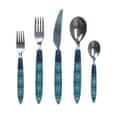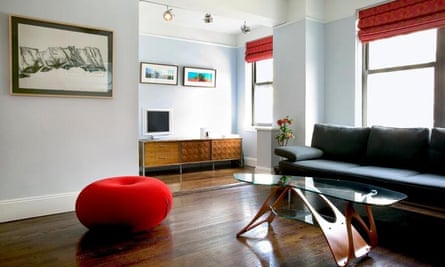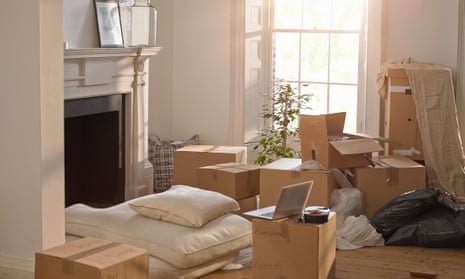Just over a year ago, I stood in an empty house in south east London, watching my belongings get packed up and shipped across the Atlantic to New York City. Now, after only 13 months, I’m preparing to move everything back again.
The Guardian’s product and service reviews are independent and are in no way influenced by any advertiser or commercial initiative. We will earn a commission from the retailer if you buy something through an affiliate link. Learn more.
Moving is a special kind of hell – but it’s one that I’m used to. As a child of a military officer, I moved with alarming regularity through my youth. In total, I’ve moved nearly 25 times and in the process I’ve become a bit of an expert on how to do it right. The most important thing? Make your new place feel like home as quickly as possible. When you’re in a new place, with lots of things to do, people to meet, and new neighborhoods to explore it can seem like a real chore to go furniture and homeware shopping. But coming back to an empty, cardboard box-filled apartment every day is a sure way to feel homesick.
If you, like me, are facing another set of boxes to pack and unpack in the near future, here’s a little guide for how to make your new place feel a little less like the shell of someone else’s and a little more like your own.
Mix old and new furnishings

This might sound obvious but when you move, especially if it’s to a different city or country, take some things that remind you of home. I shipped some pictures and ornaments that had decorated my London home, as well as a few choice pieces of “investment” furniture.
You can’t bring everything, so you’ll have to buy some new stuff – but avoid, as far as your budget allows, relying too much on Ikea or else your place will start to look like it came in a box. Ikea is best for a few practical bits and pieces like the Billy bookshelf, all-in-one box 12-piece dinnerware sets in neutral colours, good-value pots and pans and cutlery (the stainless steel Sedlig set looks way more expensive than it is), and duvets, pillows and bedsheets which can be dressed up with interesting covers.
Make unpacking your priority

Unpack quickly – and recycle the boxes. But take care to shake out every piece of packing paper and bubble wrap. My parents once lost a valuable miniature painting in a move, which was likely just chucked out with a load of paper.
Pictures, plants and candles add instant atmosphere
Put pictures up as soon as you can. Having familiar artwork around helps you feel at home, and makes your new place look more lived in immediately. Make sure they’re framed though – nothing screams “temporary” like posters tacked to walls.
Good lighting is also important. Don’t leave bare bulbs hanging for any longer than you have to, and invest in table lamps to create cozy surroundings as soon as you can. Plants instantly make a place feel put together. As do candles (the Danes are really onto something there). Scented options, such as my favourite Diptyque Figuerie, give you both a welcoming glow and a comforting, familiar scent instantly.
Mix and match
Try and mix it up a bit with furniture or homegoods bought from a variety of stores, which will make it feel like you’ve put your home together over time, rather than in a single trip to a blue and yellow superstore. Urban Outfitters does good value, mid-century style furniture that looks spot on in an NYC apartment, West Elm offers a similar aesthetic and is great for interesting and affordable lighting. If you can afford a sofa from Room & Board in the US or John Lewis in the UK, it’ll look much better than a generic Ikea option. Wayfair and Overstock also offers good-value options if you’re willing to wade through the massive inventory. It can be worth it though. I picked up a pair of industrial barstools for less than $100.

Get rid of what you don’t want – but selling it isn’t always the answer
Moving is a great excuse to clear out things you don’t want anymore, but decluttering and getting rid of larger possessions like furniture can be harder than you think, especially when you have a deadline. There are loads of ways to sell things online from Craigslist and Gumtree, to more upscale sites like AptDeco or apps such as Let Go. But they all take time and effort, which is probably the last thing you want when planning a big move. And timing is everything – you’ll probably need your bed and sofa right up to the day you move, yet your buyer might not be able to pick it up on the day you need them to.
Donating furniture is tricky
Donating unwanted goods is another way to declutter. Again, don’t assume that your timeline will work for the organization you’re donating to. When I tried to donate my London sofa before moving to America, I struggled to find a charity that could commit to picking it up in time, but the likes of British Heart Foundation in London and Housing Works and the Salvation Army in New York organize pick-ups for larger items if you plan ahead.
Donating and selling are much better alternatives than, say, leaving your stuff on the curb. But they take planning, so make sure you start the process early.
Sell your clothes

My rule is that if I haven’t worn something at least three times since I moved to NYC then it’s not coming with me to London. This means a huge piles of clothes and tons of pairs of shoes need to be donated. But that takes time. All items need to be washed and folded before a concession store (like Beacon’s Closet or Buffalo Exchange) will accept them. They also need to be in-season.
Another option is to take old stuff into major stores, like Madewell and & Other Stories, who accept clothes for recycling in exchange for discount vouchers for new gear. Although that’s not really going to solve the decluttering problem is it?

Comments (…)
Sign in or create your Guardian account to join the discussion